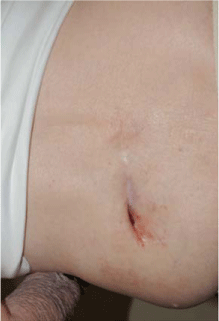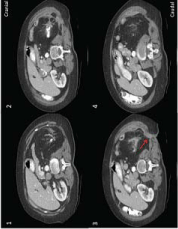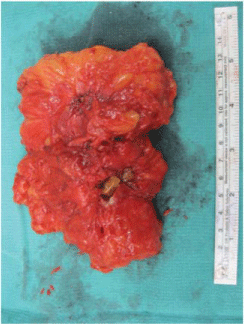Case Report
A Nephrocutaneous Fistula Presenting as a Chronic Back Wound
Ranganathan K1, Montgomery JS2 and Kozlow JH1*
1Department of Surgery, University of Michigan, USA
2Department of Urology, University of Michigan, USA
*Corresponding author: Jeffrey Kozlow, Department of Surgery, University of Michigan, 1500 East Medical Center Drive, Taubman Center, SPC 5340, Ann Arbor, MI 48109-0219, USA
Published: 10 Aug, 2016
Cite this article as: Ranganathan K, Montgomery JS, Kozlow JH. A Nephrocutaneous Fistula Presenting as a Chronic Back Wound. Clin Surg. 2016; 1: 1079.
Abstract
Renal replacement lipomatosis is a rare condition that when arises usually presents as back or
flank pain, dysuria, or an abdominal mass. We present a case of renal replacement lipomatosis that
presented instead as a chronic back wound. Given that this pathology is readily treated with surgical
intervention when performed in a timely manner, it is important to consider this as a possible
diagnosis when chronic back wounds deviate from the expected time course of healing.
Keywords: Renal replacement lipomatosis; Chronic wound; Nephrolithiasis
Introduction
Renal Replacement Lipomatosis (RRL) is the deposition of adipose tissue in place of renal parenchyma. As this condition usually occurs in the presence of local chronic inflammatory states, approximately 70% of RRL are associated with calculous disease [1]. Previously reports document dysuria, hematuria, flank/abdominal pain, or abdominal mass as the initial stimulus leading to a diagnosis of RRL. We present a documented case of RRL that manifested instead as a recurrent back wound secondary to a nephro-cutaneous fistula. In the work-up of a recurrent flank wound without an obvious source, it is important to consider RRL as a possible etiology given that surgical intervention is the only potential cure.
Case Presentation
An 85-year-old female presented for evaluation of a chronic wound over the left back. On
initial presentation in 1992, physical exam was thought to be consistent with epidermoid cyst
formation after which time excision and primary closure were performed. Repeat excisions at this
site were performed on five separate occasions between 1992 and 2011 by the patient’s primary
care physician, dermatologist, and surgical oncologist only to result in recurrence within 3-5 years
after each excision. Pathology of these lesions demonstrated inflammatory tissue. Non-operative
management with use of dressing changes failed each time.
Physical exam demonstrated a 1-cm wound over the left mid-back with granulation tissue
at the base of a 5 cm deep tract (Figure 1). Due to concern for a fistula as the cause of delayed
healing, a Computed Tomography (CT) scan was performed (Figure 2). Creatinine was .8. The scan
demonstrated almost complete lipomatous replacement of the left kidney with a large stag horn
calculus present along side a nephrocutaneous fistula. Originating from the remnant left kidney was
a fistula tract through the paraspinous muscle and into the subcutaneous space consistent with the
wound noted on physical exam.
A diagnosis of renal replacement lipomatosis was made. Based on the etiology of the recurrent
wound, the patient underwent open radical left nephrectomy with excision of the nephro-cutaneous
fistula tract. The previous fistula tract was closed with a paraspinous muscle advancement flap to
reinforce the closure. The excised, remnant kidney is seen in Figure 3. Pathologic examination
showed an end-stage kidney with extensive replacement of the renal parenchyma with scar, chronic
inflammation, dystrophic calcification, and lipomatous changes with thyroidization of the residual
kidney parenchyma without neoplastic change. Her post-operative course was complicated by
a psoas abscess presenting at six months post-operative and centered on a retained stone in the
operative bed. This was treated with percutaneous drainage, targeted intravenous antibiotic therapy,
and wound care via her nephrectomy incision. The site of the previous fistula remained well-healed.
Figure 1
Figure 1
A wound over the left mid-portion of the back that is approximately
one centimeter in diameter is evident on physical exam. Serous fluid
was easily expressed from this wound cavity which extended into the
subcutaneous and deeper tissues by approximately five centimeters.
Figure 2
Figure 2
CT scan of the abdomen and pelvis demonstrates multiple fistulous
tracts extending from the lipomatous kidney through the perinephric space
and into the subcutaneous tissue of the lumbar region. There is complete
replacement of the left kidney with lipomatous tissue. The right kidney is
normal.
Discussion
Renal Replacement Lipomatosis (RRL) is a degenerative process
within the kidney that worsens in severity as the kidney becomes
atrophic due to replacement of parenchyma by increasing amounts
of adipose tissue [2]. The rarity of this disease process makes this
a very difficult diagnosis to make. First described by Brown et al
in 1861, RRL most commonly occurs in patients between fifty to
seventy years of age. Patients may present with symptoms such as
flank pain, weight loss, hematuria, and a palpable mass on exam [2].
Often associated with unilateral hydronephrosis, calculous disease,
and frequent urinary tract infections, we can now add recurrent
back wounds and nephro-cutaneous fistula formation to this list of
associated complications [3].
Given the nonspecific symptomatology common to this disease
process, imaging studies are of utmost importance should this
diagnosis be suspected. Both CT and MRI are valuable studies,
although CT is the more commonly employed in such settings [4-
7]. While a broad differential diagnosis including angiomyolipoma,
xanthomatous pyelonephritis, renal lipoma, and liposarcoma is
necessary given the rarity of RRL, CT scan can clearly differentiate
these conditions from one another [1,5,8]. Microscopic findings
include proliferation of the renal parenchyma with large adipocytes
and inflammatory cells. On gross examination, the kidney and
perinephric space will be engulfed by tough, fibrous fatty tissue.
Unilateral nephrectomy is the standard of care in such cases
given that the affected kidney is usually non-functional by the
time the diagnosis of RRL is made [9]. In cases of concomitant
nephrocutaneous fistula formation in the setting of RLL, we advise
complete excision of the fistula with closure performed in an
immediate fashion [10]. Following excision, we believe that local
muscle flap coverage of the resultant defect will decrease the risk of
fistula recurrence. Both paraspinous muscle flaps and latissimus dorsi
flaps are standard reconstructive tools that should be considered.
Thus, it must be acknowledged that immediate surgical intervention
with a robust closure are required to optimize the likelihood of
successful long-term resolution.
Figure 3
Figure 3
The excised kidney demonstrates evidence of parenchymal
atrophy due to the substitution of fat for renal parenchyma. A kidney stone is
visible within the specimen.
Conclusions
Renal replacement lipomatosis should be considered not only in patients presenting with abdominal pain, a flank mass, or dysuria in a setting of frequent urinary tract infections or kidney stones, but also in patients who present with chronic wounds of the flank region. Although a rare finding, consideration of this diagnosis is imperative in those cases deemed unresponsive to previous management strategies. CT scan is easily able to delineate RRL from other disease processes making early diagnosis and treatment possible, thus minimizing the emotional impact that such a disease process may have on patients suffering from this difficult yet readily treatable disease process.
References
- Sakata Y, Kinoshita N, Kato H, Yamada Y, Sugimura Y. Coexistence of renal replacement lipomatosis with xanthogranulomatous pyelonephritis. Int J Urol. 2004; 11: 44-46.
- Romero FR, Pilati R, Caboclo MF, Silva AP, Cravo MA, Brenny FT. Renal replacement lipomatosis and xanthogranulomatous pyelonephritis: differential diagnosis. Rev Assoc Med Bras. 2011; 57: 262-265.
- Chang SD, Coakley FV, Goldstein RB. Renal replacement lipomatosis associated with renal transplantation. Br J Radiol. 2005; 78: 60–61.
- Shah VB, Rupani, AB, Deokar MS, Pathak HR. Idiopathic renal replacement lipomatosis: a case report and review of literature. Indian J Pathol and Microbiol. 2009; 52: 552-553.
- Nicholson DA. Case report: replacement lipomatosis of the kidneyunusual CT features. Clin Radiol. 1992: 45: 42-43.
- Honda H, McGuire CW, Barloon TJ, Hashimoto K. Replacement lipomatosis of the kidney: CT features. J Comput Assist Tomogr. 1990; 14: 229-231.
- Kocaoglu M, Bozlar U, Sanal HT, Guvenc I. Replacement lipomatosis: CT and MRI findings of a rare renal mass. Br J Radiol. 2007; 80: 287-289.
- Xu Y, Liu RL, Zhang ZH, Zhao WM, Yang QC. Renal replacement lipomatosis. Eur Surg Res. 2006; 38: 385-387.
- Khan M, Nazir SS, Ahangar S, Farooq Q SJ, Salroo NA. Total renal replacement lipomatosis. Int J Surg. 2010; 8: 263-265.
- Kiris A, Kocakoc E, Poyraz AK, Dagli F, Boztosun Y. Xanthogranulomatous pyelonephritis with nephrocutaneous fistula and co- existing renal replacement lipomatosis: the report of a rare case. Clin Imaging. 2005; 29: 356–358.



